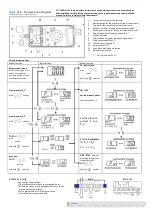
L-DALI User Manual
131
LOYTEC
Version 5.2
LOYTEC electronics GmbH
If an e-mail cannot be sent (e.g. the mail server is not reachable), the mail delivery is retried
up to 24 times every 30 minutes.
6.4.6
Historic Filters
For certain applications historic values of a given base data point, both recent and far into
the past, can be of interest. This can be accomplished with
historic filters
. Historic filters
allow processing historic values of the base data point according to a filter function. One or
more such functions can be defined per base data point. The result of the historic filter is
written to
historicFilter
property relations. For each historic filter function a time period can
be defined at which the base value is sampled, e.g., every first of the month at midnight, and
how many samples ago. Historic filters can be created for any analog, binary, or multi-state
data point. It is not necessary to create a trend log.
The following sampling periods can be defined:
Value every
x
minutes aligned to full hour (
x
= 1, 2, 5, 10, 15, 20, 30 min), 0 or 1
samples ago,
Hourly value at full hour, 0..24 samples ago,
Daily value at HH:MM:SS of the day, 0..60 samples ago,
Weekly value at HH:MM:SS on weekday (Mon..Sun), 0..10 samples ago,
Monthly value at HH:MM:SS on day of month (1..31, last), 0..24 samples ago,
Yearly value at HH:MM:SS on DD/MM of the year, 0..5 samples ago.
By using historic filter data points it is possible to implement numerous calculations on
historic values of the base data point. For example it is possible to create two filter data
points with a daily sampling period recording the energy consumption at midnight, one
holding the most current sample (today at midnight) and the other the previous sample
(yesterday day at midnight). This is shown in Figure 119.
Figure 119: Example historic filters for daily consumption.
For calculating the difference between the current value and any historic value, the filter
definition can be configured in a delta mode. This is a shortcut to creating a math object
subtracting the historic filter data point value from the current value of the underlying data
point or the value of another filter item. The example shows two results: Filter item ‘2’
yields the consumption to-the-hour of the current day (subtract value at midnight from
current value). Filter item ‘3’ yields yesterday’s consumption (subtract the value of
















































